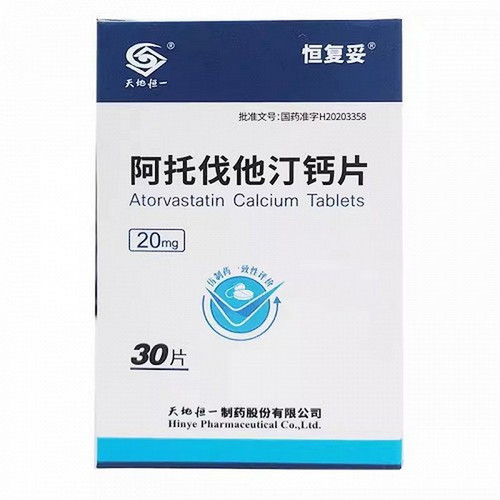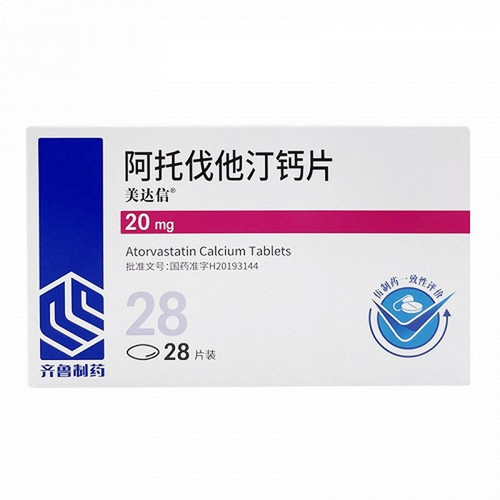Product Overview
[Drug Name]
Generic Name: Atorvastatin Calcium Capsules
Trade Name: Youjia Atorvastatin Calcium Capsules, 20mg x 10 capsules
[Main Ingredients]
The main ingredient of this product is atorvastatin calcium, chemically known as [R-(R,R)]-2-(4-fluorophenyl)-β,β-dihydroxy-5-(1-methylethyl)-3-phenyl-4-[(anilino)carbonyl]-1-hydrogen-pyrrole-1-heptanoate calcium trihydrate.
[Properties]
Atorvastatin calcium capsules are hard capsules containing white granules or powder.
[Indications/Main Functions]
This product is indicated for the treatment of elevated total cholesterol, LDL cholesterol, apolipoprotein B, and triglycerides in patients with primary hypercholesterolemia, including familial hypercholesterolemia (heterozygous) or combined hyperlipidemia (equivalent to Fredrickson classification types Ia and Ib), who have not responded satisfactorily to dietary therapy and other non-drug therapies. In patients with homozygous familial hypercholesterolemia, atorvastatin calcium can be used in combination with other lipid-lowering therapies or alone (when other treatment options are unavailable) to lower total cholesterol and LDL cholesterol.
[Specifications]
20mg x 10 capsules
[Dosage and Administration]
Patients should follow a standard low-cholesterol diet before initiating treatment with this product and maintain a healthy diet throughout treatment. The dose should be individually adjusted based on baseline LDL cholesterol levels, treatment goals, and the patient's response to treatment. The usual starting dose is 10 mg once daily. Dose adjustments should be made every four weeks or longer. The maximum dose of this drug is 80 mg once daily. It can be taken at any time of day, regardless of mealtime. For patients with established coronary artery disease or other patients at increased risk of ischemic events, the treatment goals are LDL-C <3 mmol/L (or <115 mg/dL) and total cholesterol <5 mmol/L (or <190 mg/dL). For the treatment of primary hypercholesterolemia and mixed hyperlipidemia, most patients can achieve lipid control with atorvastatin calcium 10 mg once daily. Significant efficacy is seen within two weeks of treatment, and substantial efficacy within four weeks. Long-term treatment maintains efficacy. For patients with heterozygous familial hypercholesterolemia, the initial dose is 10 mg daily. Dosage should be individualized and titrated to 40 mg daily at four-week intervals. If satisfactory efficacy is still unsatisfactory, the dose can be increased to a maximum of 80 mg daily or 40 mg of this drug combined with a bile acid sequestrant can be used. Homozygous familial hypercholesterolemia In a charitable study involving 64 patients, 46 of whom had corresponding LDL receptor information, the average LDL-C level of these 46 patients decreased by 21%. The dose of this product can be increased to 80 mg per day. For patients with homozygous familial hypercholesterolemia, the recommended dose of this product is 10 to 80 mg per day. Atorvastatin calcium should be used as an adjunct to other lipid-lowering treatments (such as LDL plasma dialysis). Or when these treatment conditions are not available, this product can be used alone. Dosage for patients with renal insufficiency Renal disease will not affect the plasma concentration of this product or its lipid-lowering effect, so no dose adjustment is required.
[Adverse Reactions]
This product should not be taken by patients with rare genetic diseases such as galactose intolerance, human lactose deficiency, or glucose-galactose malabsorption.
[Contraindications]
(1) This product is contraindicated in patients who are allergic to any of the ingredients contained in it. (2) This product is contraindicated in patients with active liver disease, patients with persistent elevation of serum transaminases exceeding 3 times the upper limit of normal for unknown reasons, patients with myopathy, pregnant women, lactating women, and women of childbearing age who have not taken appropriate contraceptive measures.
[Drug Interactions]
Drug interactions may occur if used with other drugs. Please consult a physician or pharmacist for details.
[Precautions]
Digoxin: When 10 mg of Yujia Atorvastatin Calcium Capsules is co-administered with multiple doses of digoxin, the steady-state plasma concentration of digoxin is not affected. When this product is co-administered with digoxin at a dose of 80 mg once daily, the digoxin concentration increases by approximately 20%. This is due to the inhibition of the cell membrane transport protein P-glycoprotein. Patients taking digoxin should be appropriately monitored. Oral contraceptives: When this product is used in combination with oral contraceptives, the plasma concentrations of norethindrone and ethinyl estradiol increase. When choosing oral contraceptives, attention should be paid to the increased concentrations. Colestipol (Cholestyramine): When colestipol is coadministered with this medication, plasma concentrations of atorvastatin and its active metabolite decrease by 25%. However, the lipid-lowering effect of the combined medication is greater than that of either medication alone. Antacids: When this medication is coadministered with an oral antacid suspension containing magnesium hydroxide and aluminum hydroxide, plasma concentrations of atorvastatin and its active metabolite decrease by approximately 35%, but their LDL-cholesterol-lowering effect is unaffected. Warfarin: When this medication is coadministered with warfarin, prothrombin time decreases slightly within the first few days, returning to normal after 15 days. Nevertheless, patients taking warfarin should be closely monitored when this medication is added to their warfarin regimen. Amitraz: Multiple doses of this medication have not been shown to affect the clearance of amitraz. Cimetidine: Interaction studies with this medication have not revealed any interaction between the two drugs. Amlodipine: The pharmacokinetics of atorvastatin at steady-state concentrations were unchanged when atorvastatin 80 mg was coadministered with amlodipine 10 mg. Other: No clinically significant drug interactions were observed in clinical trials of this product with antihypertensive or hypoglycemic agents.
[Use in Elderly Patients]
The efficacy and safety of atorvastatin calcium at the recommended dose in elderly patients aged 70 years and older were no different from those in the general population.






